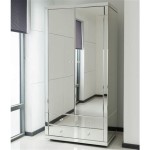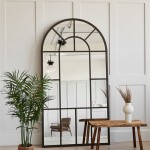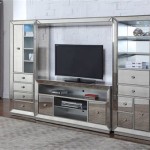How To Antique A Mirror Glass
Antiquing a mirror glass is a transformative process that replicates the aesthetic appeal of aged, vintage mirrors. Traditional methods involve the careful removal of portions of the mirror's silvering, followed by treatments to accelerate oxidation and discoloration. This creates a unique, mottled effect that evokes a sense of history and character. Antique mirrors are popular for decorative purposes, adding visual interest and a touch of elegance to diverse interior design styles. This article provides a comprehensive guide to antiquing a mirror glass, outlining the necessary materials, safety precautions, and step-by-step procedures involved.
The techniques employed to antique a mirror can range from relatively simple to more complex, depending on the desired level of aging and the specific effects one wishes to achieve. Regardless of the chosen method, the underlying principle remains the same: selectively remove or degrade sections of the reflective backing to reveal the underlying glass and introduce elements that mimic natural aging processes. This results in a mirror that appears to have weathered the passage of time, acquiring a distinctive patina and visual texture.
Safety Precautions and Materials
Prior to commencing the antiquing process, prioritize safety by assembling the essential protective gear. This includes, but is not limited to, chemical-resistant gloves to safeguard hands from potentially corrosive substances, safety glasses to protect eyes from splashes and fumes, and a respirator or face mask to prevent inhalation of fine particles or vapors. Working in a well-ventilated area is also crucial to minimize exposure to potentially harmful fumes released during the chemical treatments.
The materials required for antiquing a mirror vary depending on the chosen method, but typically include the following:
- Mirror Glass: Select a mirror of the desired size and shape. Consider the thickness of the glass, as thicker glass is generally more durable and less prone to breakage during the process.
- Mirror Stripper: A chemical compound specifically designed to remove the reflective backing from the mirror. Numerous products are available; research and select one that is suitable for the type of mirror backing you are working with.
- Spray Bottles: Clean, empty spray bottles are used to apply the various chemical solutions directly to the mirror surface.
- Chemicals for Aging: A range of chemicals can be employed to create the desired aging effect, including diluted muriatic acid (hydrochloric acid), bleach, vinegar, ammonia, and hydrogen peroxide. The specific selection and concentration will depend on the desired aesthetic outcome.
- Brushes and Sponges: Soft-bristled brushes and sponges are useful for applying and manipulating the chemical solutions on the mirror surface, creating different textures and patterns.
- Painter's Tape: Used to mask off sections of the mirror that you wish to protect from the antiquing process, creating defined edges and patterns.
- Drop Cloth or Protective Surface: Cover the work area with a drop cloth or other protective material to prevent damage from spills and splatters.
- Neutralizer: A solution to neutralize the chemical reactions after the antiquing process is complete. Baking soda and water solution is a common option.
- Sealant (Optional): A clear sealant can be applied to the back of the mirror to protect the remaining silvering and prevent further deterioration.
The Antiquing Process: A Step-by-Step Guide
With the necessary safety precautions in place and all materials assembled, the antiquing process can begin. The following steps outline a general procedure; specific adjustments may be necessary based on the desired effect and the chosen materials.
- Preparation: Begin by thoroughly cleaning the mirror surface with a glass cleaner and a microfiber cloth to remove any dirt, grease, or fingerprints. Ensure the mirror is completely dry before proceeding.
- Masking (Optional): If specific areas of the mirror should remain unaffected by the antiquing process, carefully apply painter's tape to create defined boundaries.
- Silvering Removal: Apply the mirror stripper according to the manufacturer's instructions. This typically involves spraying the stripper onto the back of the mirror and allowing it to dwell for a specified period. The silvering will begin to dissolve or lift away from the glass. Use a scraper or putty knife to carefully remove the loosened silvering. Be gentle to avoid scratching the glass.
- Creating Patterns: Once the majority of the silvering has been removed, experiment with different techniques to create patterns on the remaining silver. Use a brush or sponge to dab or streak the stripper, selectively removing more silvering in certain areas. Alternatively, use a scraper to create linear scratches or other textures.
- Aging with Chemicals: After achieving the desired silvering pattern, proceed to the aging process. This involves applying diluted chemicals to oxidize the remaining silvering and create a tarnished, aged appearance. Muriatic acid, bleach, vinegar, and ammonia can all be used to achieve different effects. Experiment with varying concentrations and application methods to achieve the desired level of aging.
- Applying Chemicals: Diluted muriatic acid creates a more aggressive aging process, producing blotchy patterns and a distinct oxidation. Bleach can create a mottled effect, while vinegar provides a gentler tarnishing effect. Ammonia can create a subtle discoloration and contribute to an aged patina. Hydrogen peroxide can be used to speed up the oxidation process, especially in conjunction with other chemicals.
- Controlling the Reaction: Carefully monitor the chemical reactions as they occur. The duration of exposure to the chemicals will determine the extent of the aging. Use a spray bottle to mist the chemicals onto the mirror surface, and observe the changes that occur. Control the pattern by blotting or wiping areas as desired, or adding more chemicals for more effect.
- Neutralization: Once the desired level of aging has been achieved, neutralize the chemical reactions by applying a solution of baking soda and water. This will stop the oxidation process and prevent further deterioration of the silvering. Rinse the mirror thoroughly with clean water to remove any residual chemicals.
- Drying and Sealing: Allow the mirror to dry completely before proceeding to the next step. Once dry, consider applying a clear sealant to the back of the mirror to protect the remaining silvering and prevent further oxidation. This will help to preserve the antique finish over time. Do not apply sealant until all chemicals have been rinsed and the back is dry.
Achieving Different Antique Mirror Effects
The final appearance of the antique mirror can be customized by varying the techniques and materials used throughout the process. Here are some common techniques to achieve specific effects:
- Heavy Aging: This effect is characterized by significant silvering removal and pronounced oxidation. Use a stronger concentration of mirror stripper and allow it to dwell for a longer period. Apply multiple layers of aging chemicals, allowing each layer to react before applying the next.
- Subtle Aging: For a more subtle and refined antique effect, use a weaker concentration of mirror stripper and use a gentler application technique. Apply the aging chemicals sparingly, and carefully monitor the reaction to prevent over-oxidation.
- Mottled Effect: To create a mottled or speckled appearance, use a sponge or brush to dab the aging chemicals onto the mirror surface. Vary the pressure and coverage to create an irregular pattern.
- Streaked Effect: Use a brush or cloth to streak the aging chemicals across the mirror surface, creating linear patterns that mimic the natural aging process.
- Color Tinting: Add a small amount of dye or pigment to the aging chemicals to create a subtle color tint in the aged areas. This can enhance the vintage aesthetic and complement the surrounding décor.
- Layering: Create depth and complexity by layering different aging techniques. For example, begin with a base layer of subtle aging, and then add a top layer of heavy aging in select areas.
- Distressing: Incorporate physical distressing techniques, such as scratching or chipping the edges of the mirror, to further enhance the aged appearance.
Experimentation is key to mastering the art of antiquing mirror glass. By exploring different techniques and materials, and carefully observing the results, one can develop a unique style and create truly one-of-a-kind antique mirrors. Remember to always prioritize safety and work in a well-ventilated area when handling chemicals. With patience and practice, it is possible to transform ordinary mirrors into stunning works of art that add character and charm to any space.

How To Antique A Mirror Tutorial Jenna Sue Design

The Ultimate Guide On Diy Antique Mirrors So Much Better With Age

Diy Antique Mirror Easy To Do And Looks Authentic My Creative Days

The Ultimate Guide On Diy Antique Mirrors So Much Better With Age

How To Antique A Mirror Tutorial Jenna Sue Design

How To Antique A Mirror Easy Diy Tutorial

How To Antique A Mirror From The Front With Paint Average But Inspired

How To Antique A Mirror Tutorial Jenna Sue Design

How To Antique A Mirror Tutorial Jenna Sue Design

The Ultimate Guide On Diy Antique Mirrors So Much Better With Age








